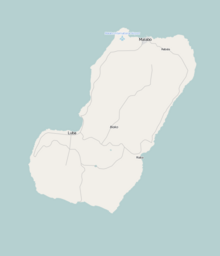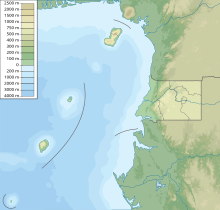geo.wikisort.org - Mountains
Pico Basilé (formerly Pico de Santa Isabel or Clarence Peak),[2] located on the island of Bioko, is the tallest mountain of Equatorial Guinea. With an altitude of 9,878 ft (3,011 m), it is the summit of the largest and highest of three overlapping basaltic shield volcanoes which form the island. From the summit, Mt. Cameroon can be seen to the northeast. Pico Basilé lies close to the city of Malabo. The very top is used as a broadcast transmitting station for RTVGE (Radio Television Guinea Ecuatorial) and microwave relay station for various communication networks.
| Pico Basilé | |
|---|---|
| Pico de Santa Isabel, Clarence Peak | |
 | |
| Highest point | |
| Elevation | 3,011 m (9,879 ft)[1] |
| Prominence | 3,011 m (9,879 ft)[1] Ranked 90th |
| Isolation | 83 km (52 mi) |
| Listing | Country high point Ultra |
| Coordinates | 3°35′00″N 8°46′00″E[1] |
| Geography | |
 Pico Basilé Location of Pico Basilé in Bioko  Pico Basilé Pico Basilé (Equatorial Guinea) | |
| Location | Bioko, Equatorial Guinea |
| Geology | |
| Mountain type | Shield volcano |
| Last eruption | 1923 |
The peak forms a part of Pico Basilé National Park, created in April 2000[3] The boundaries of Bioko Norte and Sur runs near the summit.

Bioko was formed along the Cameroon line, a major northeast-trending geologic fault that runs from the Atlantic Ocean into Cameroon. This line includes other volcanic islands in the Gulf of Guinea such as Annobón, Príncipe and São Tomé, along with the massive stratovolcano of Mount Cameroon. Unlike the three other islands which are extinct volcanoes, its last eruption occurred in 1923.
Flora and fauna
Part of the Cameroon line, the flora and fauna of Pico Basilé and Bioko as a whole are similar to that of the montane regions of adjacent Cameroon and Nigeria. Multiple range restricted species occur on Pico Basilé, and one bird, the Bioko Speirops Zoterops brunneus, is wholly restricted to the volcano's higher elevations.[4]
History
The island was inhabited in the middle of the first millennium BC by Bantu tribes from the mainland, who formed the Bubi ethnic group. Unlike other islands in the area, Bioko had an indigenous African population. The Bubi speak a Bantu language. The island has probably been inhabited by this or other Bantu-speaking groups since before the 7th century BC.
In 1472, the Portuguese navigator Fernão do Pó was the first European to sight the island while seeking a path to India.
The first ascent of the mountain by Europeans was made by English commanders between 1827 and 1828 under the Owen expedition. Its first official ascent was made in 1839 by the British John Beecroft who was later governor of the island that was once Fernando Po, now Bioko.[5]
See also
References
- "Africa Ultra-Prominences". Peaklist.org. Retrieved 2013-02-10.
- Fero, Maximiliano; Cabezas, Francisco; Aedo, Carlos; Velayos, Mauricio (2003). "Check-List of the Piperaceae of Equatorial Guinea" (PDF). Anales del Jardín Botánico de Madrid. Consejo Superior de Investigaciones Científicas “Real Jardín Botánico”. 60 (1): 46. Retrieved 15 August 2022.
- Network for Protected areas in Equatorial Guinea Archived 2011-02-02 at the Wayback Machine (in French)
- Pérez del Val, Jaime 1996. Las Aves de Bioko, Guinea Ecuatorial: Guia de Campo. Edilesa, Léon, Spain.
- Max Liniger-Goumaz (1985). Connaître la Guinée équatoriale (in French). Peuples Noirs Peuples Africains. p. 27-92.
Sources
- "Santa Isabel". Global Volcanism Program. Smithsonian Institution.
- Bioko Biodiversity Protection Program
На других языках
[de] Pico Basile
Der Pico Basilé (früher Pico de Santa Isabel) ist der höchste Berg der Insel Bioko, die zu Äquatorialguinea gehört. Mit 3011 m ist er der höchste der drei Schildvulkane, die die Insel bilden. Der Berg liegt nahe der Landeshauptstadt Malabo. Bioko wurde durch dieselbe geologische Verwerfung gebildet wie andere Inseln im Golf von Guinea.- [en] Pico Basilé
[es] Pico Basilé
Pico Basilé (antiguamente Pico de Santa Isabel) es la montaña más alta de Guinea Ecuatorial. Está localizada en la isla de Bioko, cercana a la ciudad de Malabo. Con una altitud de 3011 m (9878 pies), es la cumbre del más grande y más alto de los tres volcanes en escudo basáltico superpuestos que forman la isla. Desde la cumbre, el monte Camerún se puede ver hacia el noreste.[fr] Pico Basilé
Le pico Basilé, d'abord connu sous le nom de pico de Santa Isabel, est le point culminant de la Guinée équatoriale avec une altitude de 3 007 m[1] et l'un des sommets ultraproéminents d'Afrique. Il est situé sur l'île de Bioko, non loin de Malabo, la capitale, qui est établie sur son versant septentrional. Il se trouve au cœur d'une aire protégée, le parc national de Pico Basilé, créé en avril 2000[2].[it] Pico Basilé
Il Pico Basilé è un vulcano della Guinea Equatoriale, situata sull'isola Bioko. Si tratta della più alta montagna del Paese africano, con un'altitudine di 3011 metri. Il Pico Basilé è un vulcano a scudo di natura basaltica.[ru] Пико-Басиле
Пи́ко-Басиле́ (исп. Pico Basilé), ранее Пико-де-Санта-Исабель (исп. Pico de Santa Isabel) — высшая точка государства Экваториальная Гвинея. Это малоактивный вулкан, расположенный на острове Биоко. У северного подножья находится столица государства — город Малабо. С вершины Пико-Басиле в ясную погоду хорошо видно побережье Африканского континента, находящееся на расстоянии 55 км, и соседний вулкан Камерун, до которого 80 км. Вершина является частью Национального парка Пико-Басиле, созданного в апреле 2000 года. Остров Биоко, вместе с расположенными на нём вулканами, сформировался вдоль геологического разлома Камерун, простирающегося от Камеруна на юго-запад, в Атлантический океан (Камерунская линия). В отличие от вулканов на трёх других островах линии, Пико-Басиле активен, последнее извержение произошло в 1923 году.Другой контент может иметь иную лицензию. Перед использованием материалов сайта WikiSort.org внимательно изучите правила лицензирования конкретных элементов наполнения сайта.
WikiSort.org - проект по пересортировке и дополнению контента Википедии